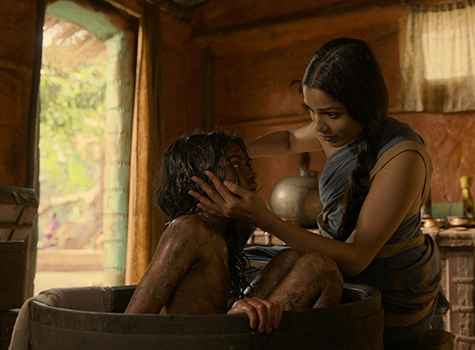Directed by Andy Serkis
Score by Nitin Sawhney
Starring: Christian Bale, Benedict Cumberbatch, Andy Serkis, Naomi Harris, Cate Blanchett, Tom Hollander, Louis Ashbourne Serkis, Freida Pinto, Matthew Rhys, and Rohan Chand

“I am the jungle’s eyes. I can see the past, and the future. It is I, Kaa, who witnessed the coming of man. And the jungle trying to survive.”
These are the first words heard as the movie begins. They are spoken the slow, patient words of the python, Kaa, portrayed in this version by Cate Blanchett. If you’ve ever seen the first few scenes of The Lord of the Rings: The Fellowship of the Ring, this scene is somewhat reminiscent of Blanchett’s haunting voiceover as Galadriel. Considering Andy Serkis (who portrayed Gollum in The Lord of the Rings trilogy) is this film’s director I doubt this thematic choice was by coincidence.
Now most people (myself included) first thought, “But why is there yet another version of The Jungle Book coming out so soon after Disney’s remake?” I think this was a passion project of Serkis’ for a long time, and if it had come out first, I think it would get much more appreciation than the Disney one. Not to say that the 2016 Disney version is bad, really. I actually like it better than the 1967 animated one. But in reality it’s like comparing an orange to a tangerine. Both are similar citrus fruits from the same family, but one is less tart with a softer center and smoother skin.
Serkis’ version is much closer to Ruyard Kipling’s original writings, using a few different stories as a basis of how Mowgli was raised and became such an important character. Many of the characters (Baloo and Bagheera in particular) are much grittier and help Mowgli more through “tough love” rather than singing about the “Bear Necessities” of life.
Kaa is female in both the 2016 and 2018 versions and male in the 1967 cartoon and Kipling’s original. While Sterling Halloway (most known as the original voice of Winnie the Pooh) is a standout of the cartoon, both Scarlett Johanssen and Cate Blanchett turn Kaa into a much more complex character. Both of them make Kaa’s demeanor seductive and yet makes your skin crawl. Honestly I prefer Blanchett’s version since she slows down her speech to the point that you actually sense that she is both extremely patient yet deadly, just like a real python.
Speaking of the animal performances, Serkis chose to use Motion Capture and it shows. While watching the animals speak, you can vaguely see the actors through them. I caught Christian Bale’s “Bat growl” in a few scenes, but I think for a Panther it’s more appropriate than for a grown man dressed in a black Kevlar bodysuit. Serkis’ tendency to poke his lower lip out while performing certain accents is also very apparent with Baloo. Unfortunately those who have seen both versions will notice that the CGI is not nearly as good in this one compared to Disney. I suspect it’s due to Warner Brothers not giving the production the funding it needed.
As for the story, it’s really two stories kind of mashed together. The first half is Mowgli finding his place in the Jungle, and the other half is him interacting with a nearby Indian village (complete with a very colorful Holi ceremony) whereas Disney chose to focus basically on Mowgli’s experiences solely with the animals and very little human interaction. Both versions do have Mowgli simply trying to find his place in the world. I think Disney’s version just knew that the journey would be a bit more lighthearted since the main protagonist (and its primary audience) is a child. Serkis bounces around between Mowgli playing and fighting for his life. It’s a tad uneven in places but I like that in the boy’s “training” sequences he is shown as extremely cunning; willing to bend the rules to keep up with his wolf brothers and sisters. Regardless, Rohan Chand and Neel Sethi do amazing work since both had to perform to characters that were not really there.
While anyone who watches this on Netflix will no doubt compare it to Disney’s, I suggest you keep in mind that both versions have their merits and both should be appreciated for those merits. Enjoy the story, the characters, and the overall aesthetic of Kipling’s Jungle world.



